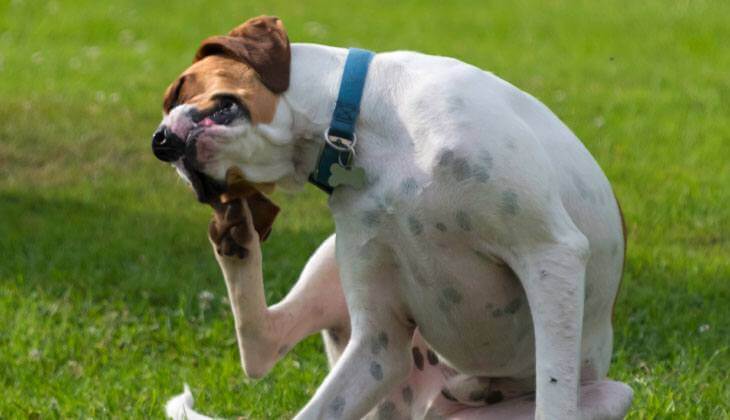Most dogs pick up fleas at least once in their lifetime. Fleas are a very common parasite found on dogs, perhaps because fleas and dogs both seem to love outdoor areas that are shady, cool and moist, like under trees and near shrubs.
Fleas are great at jumping and can quickly spread within a kennel, shelter or grooming facility, and then they can be transferred to your house. The good news is early detection can stop them from multiplying and wreaking havoc on your dog and in your home. Here are five clear signs that fleas might be feasting on your dog.
ABNORMAL SCRATCHING, LICKING AND/OR BITING
The first sign of fleas on a dog is often unrelenting scratching. Fleas like to hide in hard to reach places such as the head, neck, tail, and groin. If your dog is scratching, licking or biting these places, it is an indication of fleas.

UNUSUAL RED PATCHES
Red bumps, rashes, and irritation on your dog’s skin may be the result of a hypersensitivity to flea saliva and an indication that your dog is suffering from flea bites.
HAIR LOSS
Excessive biting and scratching of flea-covered areas may lead to a condition called alopecia (hair loss). Don’t worry! Your vet can suggest a treatment plan.
SEE FLEAS ON YOUR DOG
These are small, fast-moving brown insects that can be seen running along the skin at the bottom of the hair coat. They look very thin from above and are oval-shaped when seen from the side. Fleas have a very tough outer coat and are almost impossible to squash with your fingers.

FLEA DIRT
Flea dirt are the reddish-brown particles left on your dog’s coat and around your home. Fleas release digested blood in the form of faeces. The best way of spotting flea dirt is to pull a flea comb through your pets coat and collect the brushings on to a dampened white paper towel. If the dirt leaves a red or rustcoloured streak its likely to be flea dirt.
Check your dog for fleas regularly. If you suspect your dog has fleas, consult a vet. If fleas are confirmed, your pets will need treatment. You may also need to treat your home. Frequent vacuuming and washing of dog bedding may reduce the number of fleas in the home but it is likely that a comprehensive treatment programme will be needed which may include long-acting products for use on the pets and in some cases treatment of the home itself.
If you follow these steps, your dog should be flea-free before you know it!
Your vet plays a big role in your pet’s health. Enter your location and get a list of vets near you.
FIND A VET




